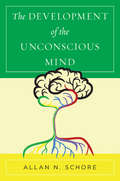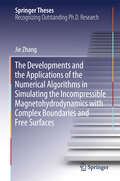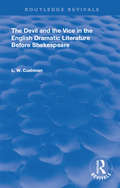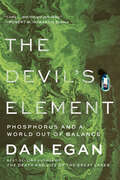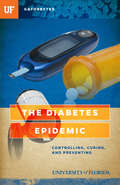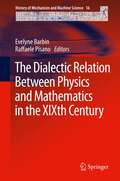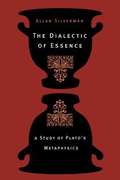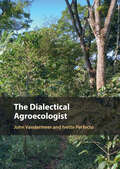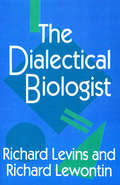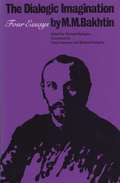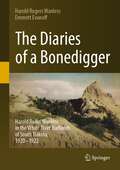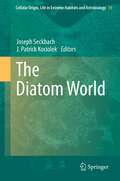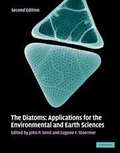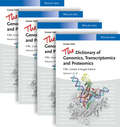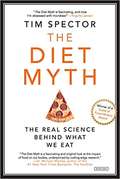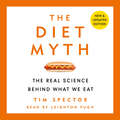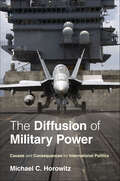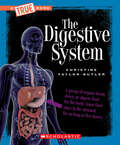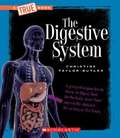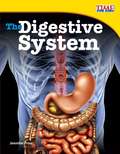- Table View
- List View
The Development of the Unconscious Mind (Norton Series on Interpersonal Neurobiology #0)
by Allan N. SchoreAn exploration of how the unconscious is formed and functions by one of our most renowned experts on emotion and the brain. This book traces the evolution of the concept of the unconscious from an intangible, metapsychological abstraction to a psychoneurobiological function of a tangible brain. An integration of current findings in the neurobiological and developmental sciences offers a deeper understanding of the dynamic mechanisms of the unconscious. The relevance of this reformulation to clinical work is a central theme of Schore's other new book, Right Brain Psychotherapy.
The Developments and the Applications of the Numerical Algorithms in Simulating the Incompressible Magnetohydrodynamics with Complex Boundaries and Free Surfaces (Springer Theses)
by Jie ZhangThis thesis presents an accurate and advanced numerical methodology to remedy difficulties such as direct numerical simulation of magnetohydrodynamic (MHD) flow in computational fluid dynamics (CFD), grid generation processes in tokamak fusion facilities, and the coupling between the surface tension force and Lorentz force in the metallurgical industry. In addition, on the basis of the numerical platform it establishes, it also investigates selected interesting topics, e.g. single bubble motion under the influence of either vertical or horizontal magnetic fields. Furthermore, it confirms the relation between the bubble’s path instability and wake instability, and observes the anisotropic (isotropic) effect of the vertical (horizontal) magnetic field on the vortex structures, which determines the dynamic behavior of the rising bubble. The direct numerical simulation of magnetohydrodynamic (MHD) flows has proven difficult in the field of computational fluid dynamic (CFD) research, because it not only concerns the coupling of the equations governing the electromagnetic field and the fluid motion, but also calls for suitable numerical methods for computing the electromagnetic field. In tokamak fusion facilities, where the MHD effect is significant and the flow domain is complex, the process of grid generation requires considerable time and effort. Moreover, in the metallurgical industry, where multiphase MHD flows are usually encountered, the coupling between the surface tension force and Lorentz force adds to the difficulty of deriving direct numerical simulations.
The Devil and the Vice in the English Dramatic Literature Before Shakespeare (Routledge Revivals)
by L. W. CushmanOriginally published in 1900, this book was the first investigation of the devil and the Vice as dramatic figures, and a study of these figures led to a new view of the subject: it is, in brief, that the appearance of the devil in the non-dramatic as well as in the dramatic literature is limited to a definite range. As a dramatic figure the devil falls more and more into the background and the Vice is distinct in origin and function from the devil.
The Devil's Doctor: Paracelsus and the World of Renaissance Magic and Science
by Philip Ball“A vibrant, original portrait of a man of contradictions,” the Renaissance-era Swiss father of modern medicine (Publishers Weekly, starred review).Philippus Aureolus Theophrastus Bombast von Hohenheim, who called himself Paracelsus, stands at the cusp of medieval and modern times. A contemporary of Luther, an enemy of the medical establishment, a scourge of the universities, an alchemist, an army surgeon, and a radical theologian, he attracted myths even before he died. His fantastic journeys across Europe and beyond were said to be made on a magical white horse, and he was rumored to carry the elixir of life in the pommel of his great broadsword. His name was linked with Faust, who bargained with the devil.Who was the man behind these stories? Some have accused him of being a charlatan, a windbag who filled his books with wild speculations and invented words. Others claim him to be the father of modern medicine. Philip Ball exposes a more complex truth in The Devil’s Doctor—one that emerges only by entering Paracelsus’s time. He explores the intellectual, political, and religious undercurrents of the sixteenth century and looks at how doctors really practiced, at how people traveled, and at how wars were fought. For Paracelsus was a product of an age of change and strife, of renaissance and reformation. And yet by uniting the diverse disciplines of medicine, biology, and alchemy, he assisted, almost despite himself, in the birth of science and the emergence of the age of rationalism.Praise for The Devil’s Doctor“An enlivening portrait that will spark interest in [Paracelsus’s] role in the rise of science.” —Booklist“A true iconoclast, [Paraclesus] inhabited an ideological landscape somewhere between the medieval and the modern. Ball effectively places Paracelsus in the larger context of Renaissance magic and philosophy, and of a turbulent period. . . . Worth the effort.” —Kirkus Reviews
The Devil's Element: Phosphorus And A World Out Of Balance
by Dan EganA New Yorker Best Book of the Year "Lively…and thought-provoking.” —Robert W. Howarth, Science The New York Times best-selling author on the source of great bounty—and now great peril—all over the world. Phosphorus has played a critical role in some of the most lethal substances on earth: firebombs, rat poison, nerve gas. But it’s also the key component of one of the most vital: fertilizer, which has sustained life for billions of people. In this major work of explanatory science and environmental journalism, Pulitzer Prize finalist Dan Egan investigates the past, present, and future of what has been called “the oil of our time.” The story of phosphorus spans the globe and vast tracts of human history. First discovered in a seventeenth-century alchemy lab in Hamburg, it soon became a highly sought-after resource. The race to mine phosphorus took people from the battlefields of Waterloo, which were looted for the bones of fallen soldiers, to the fabled guano islands off Peru, the Bone Valley of Florida, and the sand dunes of the Western Sahara. Over the past century, phosphorus has made farming vastly more productive, feeding the enormous increase in the human population. Yet, as Egan harrowingly reports, our overreliance on this vital crop nutrient is today causing toxic algae blooms and “dead zones” in waterways from the coasts of Florida to the Mississippi River basin to the Great Lakes and beyond. Egan also explores the alarming reality that diminishing access to phosphorus poses a threat to the food system worldwide—which risks rising conflict and even war. With The Devil’s Element, Egan has written an essential and eye-opening account that urges us to pay attention to one of the most perilous but little-known environmental issues of our time.
The Diabetes Epidemic: Controlling, Curing, and Prevention
by University of Florida Leonora LaPeter AntonThe University of Florida has an ambitious goal: to harness the power of its faculty, staff, students, and alumni to solve some of society’s most pressing problems and to become a resource for the state of Florida, the nation, and the world. The Diabetes Epidemic explores the complicated landscape of diabetes research and offers a glimpse of the extraordinarily difficult, and sometimes serendipitous, ways in which breakthroughs occur. At the University of Florida Diabetes Institute more than 100 faculty members are working on education, research, prevention, and treatment. Their fields are diverse—genetics, endocrinology, epidemiology, patient and physician education, health outcomes and policy, behavioral science, and rural medicine—but their goal is the same. Jump into the trenches with the doctors, scientists, and research nurses at the Diabetes Institute to learn about the challenges associated with developing treatments. Meet a brother who is helping his sister by participating in one of the largest studies ever undertaken of people at risk for Type 1 diabetes. Visit the largest open-access repository of diabetic pancreases in the world, where the most studied is that of a 12-year-old boy who had Type 1 diabetes for only a year. Spend time with one of the foremost diabetes researchers as he decides which pancreases to study, deploys experimental projects to answer new questions, and struggles to fund additional investigations. Discover why Type 2 diabetes is affecting more and more people and how some of them control it, and learn about a few of the most promising Type 2 treatments currently under study. While a cure has not yet been found, the researchers at UF’s Diabetes Institute are working to improve the lives of the estimated 415 million people currently suffering from the disease worldwide. The stories chronicled in GATORBYTES span all colleges and units across the UF campus. They detail the far-reaching impact of UF’s research, technologies, and innovations—and the UF faculty members dedicated to them. Gatorbytes describe how UF is continuing to build on its strengths and extend the reach of its efforts so that it can help even more people in even more places.
The Dialectic Relation Between Physics and Mathematics in the XIXth Century
by Raffaele Pisano Evelyne BarbinThe aim of this book is to analyse historical problems related to the use of mathematics in physics as well as to the use of physics in mathematics and to investigate Mathematical Physics as precisely the new discipline which is concerned with this dialectical link itself. So the main question is: When and why did the tension between mathematics and physics, explicitly practised at least since Galileo, evolve into such a new scientific theory? The authors explain the various ways in which this science allowed an advanced mathematical modelling in physics on the one hand, and the invention of new mathematical ideas on the other hand. Of course this problem is related to the links between institutions, universities, schools for engineers, and industries, and so it has social implications as well. The link by which physical ideas had influenced the world of mathematics was not new in the 19th century, but it came to a kind of maturity at that time. Recently, much historical research has been done into mathematics and physics and their relation in this period. The purpose of the Symposium and this book is to gather and re-evaluate the current thinking on this subject. It brings together contributions from leading experts in the field, and gives much-needed insight in the subject of mathematical physics from a historical point of view.
The Dialectic of Essence: A Study of Plato's Metaphysics
by Allan SilvermanThe Dialectic of Essence offers a systematic new account of Plato's metaphysics. Allan Silverman argues that the best way to make sense of the metaphysics as a whole is to examine carefully what Plato says about ousia (essence) from the Meno through the middle period dialogues, the Phaedo and the Republic, and into several late dialogues including the Parmenides, the Sophist, the Philebus, and the Timaeus. This book focuses on three fundamental facets of the metaphysics: the theory of Forms; the nature of particulars; and Plato's understanding of the nature of metaphysical inquiry. Silverman seeks to show how Plato conceives of "Being" as a unique way in which an essence is related to a Form. Conversely, partaking ("having") is the way in which a material particular is related to its properties: Particulars, thus, in an important sense lack essence. Additionally, the author closely analyzes Plato's idea that the relation between Forms and particulars is mediated by form-copies. Even when some late dialogues provide a richer account of particulars, Silverman maintains that particulars are still denied essence. Indeed, with the Timaeus's introduction of the receptacle, there are no particulars of the traditional variety. This book cogently demonstrates that when we understand that Plato's concern with essence lies at the root of his metaphysics, we are better equipped to find our way through the labyrinth of his dialogues and to better appreciate how they form a coherent theory.
The Dialectical Agroecologist
by John Vandermeer Ivette PerfectoThis book examines contradictions within the fields of food studies and agroecology, from the differences between traditional and scientific knowledge, to habitat fragmentation and connection, monocultures versus diverse farming systems, pest regulation, and the rural/urban dialectic. Building and expanding on the work of Richard Levins and Richard Lewontin, who used the dialectical method in the field of biology, this analysis includes examples from the authors' own pioneering research in Mexico, Nicaragua, and Puerto Rico, to demonstrate the benefits of applying the dialectical method to agroecology in practice. Exploring themes in studies that are currently the subject of rigorous debate among academics and activists alike, especially related to food production and distribution, this book is indispensable for practitioners and activists seeking to transform the food system, as well as for social and natural scientists.
The Dialectical Biologist
by Richard Levins Richard LewontinScientists act within a social context and from a philosophical perspective that is inherently political. Whether they realize it or not, scientists always choose sides. The Dialectical Biologist explores this political nature of scientific inquiry, advancing its argument within the framework of Marxist dialectic. These essays stress the concepts of continual change and codetermination between organism and environment, part and whole, structure and process, science and politics. Throughout, this book questions our accepted definitions and biases, showing the self-reflective nature of scientific activity within society.
The Dialogic Imagination: Four Essays
by Caryl Emerson Mikhail M. Bakhtin Michael HolquistThese essays reveal Mikhail Bakhtin (1895-1975), known in the West largely through his studies of Rabelais and Dostoevsky as a philosopher of language, a cultural historian, and a major theoretician of the novel. The Dialogic Imagination presents, in superb English translation, four selections from Voprosy literatury i estetiki (Problems of literature and esthetics), published in Moscow in 1975. The volume also contains a lengthy introduction to Bakhtin and his thought and a glossary of terminology. Bakhtin uses the category "novel" in a highly idiosyncratic way, claiming for it vastly larger territory than has been traditionally accepted. For him, the novel is not so much a genre as it is a force, "novelness," which he discusses in "From the Prehistory of Novelistic Discourse. " Two essays, "Epic and Novel" and "Forms of Time and of the Chronotope in the Novel," deal with literary history in Bakhtin's own unorthodox way. In the final essay, he discusses literature and language in general, which he sees as stratified, constantly changing systems of subgenres, dialects, and fragmented "languages" in battle with one another.
The Diaries of a Bonedigger: Harold Rollin Wanless in the White River Badlands of South Dakota, 1920–1922
by Emmett Evanoff Harold Rogers WanlessThrough the original writings and photography of renowned geologist Harold Rollin Wanless, this book paints a thorough and engaging picture of the White River Badlands’ landscape, geology, biology, pioneer settlers, and how life was lived 100 years ago in a harsh, challenging, remote setting. In the summer of 1920, Harold Rollin Wanless, fresh from an undergraduate geology degree at Princeton, spent the first of three summers in the Badlands of South Dakota camping, hiking, and collecting fossil vertebrate skulls. Harold produced a fascinating and thorough diary and report, illustrated with over 100 image plates, in which he explains the geology, biology, and climate of this famous area. Wanless became deeply involved with and vividly records the life, hopes, trials and character of the new homesteading pioneers of the area, and the people and livelihoods he encountered are reflected in the diary as well. This is an engaging look at the history, environment, people and geological character of a unique portion of the American West. Combining a first-hand look at the White River Badlands and its people a century ago with the fossil history contained in its Cenozoic sediments gives a well-rounded historical presentation. This diary was found, compiled, and edited by Drs. Harold Rogers Wanless (the diarist’s son and an accomplished geologist himself) and Emmett Evanoff. In the introductory and concluding chapters of this book, they provide a broader perspective of Harold Rollin Wanless’s life and his significant achievements beyond the Badlands venture described here. In addition, this narrative - written “only” a century ago - provides a stark contrast with how we travel, communicate, conduct research and survive today, yet shows that human curiosity and kindnesses have not changed.
The Diatom World
by Joseph Seckbach Patrick KociolekDiatom biology, genomics and ecology are becoming more relevant to the human species. While there have been recent compilations of some of the applied aspects of diatoms, and the dizzying pace of taxonomic revisions, this new volume bring us up to date on their classification, biology and ecology, as well as covering the topics of genomics and applied uses. In this collection, some of the leaders in diatom research present either new information or summarize recent research efforts on a wide range of topics, including the tree of life of diatoms, their classifications, the wide habitats and ecological spectra the group exploits, as well as the beauty of their form. This volume celebrates the diversity, emerging areas of research and fascinating ecology of the diatoms bringing this group of world-renown and emerging research leaders together. 'The Diatom World' will foster greater appreciation and research contributions on this incredibly diverse and fascinating group of organisms.
The Diatoms
by F. E. Round R. M. Crawford D. G. MannIllustrated descriptions of over 250 genera of diatoms are presented for the first time in this wide-ranging volume. The introduction describes the diatom cell in detail, the structure of the wall (often extremely beautiful designs), the cell contents and aspects of life cycle and cell division. The generic atlas section is the first account of diatom systematics since 1928, and each generic description is accompanied by scanning electron micrographs to show the characteristic structure.
The Diatoms: Applications for the Environmental and Earth Sciences
by John P. Smol Eugene F. StoermerDiatoms are microscopic algae which are found in virtually every habitat where water is present. This volume is an up-to-date summary of the expanding field of their uses in environmental and earth sciences. Their abundance and wide distribution, and their well-preserved glass-like walls make them ideal tools for a wide range of applications as both fossils and living organisms. Examples of their wide range of applications include as environmental indicators, for oil exploration, and for forensic examination. The major emphasis is on their use in analysing ecological problems such as climate change, acidification and eutrophication. The contributors to the volume are leading researchers in their fields and are brought together for the first time to give a timely synopsis of a dynamic and important area. This book should be read by environmental scientists, phycologists, limnologists, ecologists and palaeoecologists, oceanographers, archaeologists and forensic scientists.
The Dictionary of Genomics, Transcriptomics and Proteomics
by Guenter KahlNow in its fifth edition and for the first time available as an electronic product with all entries cross-linked. This very successful long-seller has once again been thoroughly updated and greatly expanded. It now contains over 13,000 entries, and comprehensively covering genomics, transcriptomics, and proteomics. Each entry contains an extensive explanation, including a comprehensive listing of synonyms and acronyms, and all formulas have been redrawn to create a uniform style, while most of the figures are custom designed for this dictionary. The ultimate reference for all terms in the -omics fields.
The Dictionary of Science for Gardeners: 6000 Scientific Terms Explored and Explained (Science For Gardeners Ser.)
by Michael AllabyA Library Journal Best Reference Pick of 2015! Every gardener is a scientist. Pollination, native plants, ecology, climatology—these are just a few of the scientific concepts that play a key role in a successful garden. While the ideas are intuitive to many gardeners, they are often discussed in unfamiliar scientific terms. The Dictionary of Science for Gardeners is the first of its kind to provide practical scientific descriptions for gardening terms. Highlighting 16 branches of science that are of particular interest to gardeners, with entries from abaptation to zoochory, Michael Allaby explores more than 6,000 terms in one easy-to-use reference.
The Diet Myth: The Real Science Behind What We Eat
by Professor Tim SpectorFully updated throughout and with a new foreword for this edition.Why do most diets fail? Why does one person eat a certain meal and gain weight, while another eating the same meal loses pounds? Why, despite all the advice about what to eat, are we all still getting fatter?The answers are much more surprising - and fascinating - than we've been led to believe. The key to health and weight loss lies not in the latest fad diet, nor even in the simple mantra of 'eat less, exercise more', but in the microbes already inside us. Drawing on the latest science and his own pioneering research, Professor Tim Spector demystifies the common misconceptions about fat, calories, vitamins and nutrients. Only by understanding what makes our own personal microbes tick can we overcome the confusion of modern nutrition, and achieve a healthy gut and a healthy body.
The Diet Myth: The Real Science Behind What We Eat
by Professor Tim SpectorFully updated throughout.Why do most diets fail? Why does one person eat a certain meal and gain weight, while another eating the same meal loses pounds? Why, despite all the advice about what to eat, are we all still getting fatter?The answers are much more surprising - and fascinating - than we've been led to believe. The key to health and weight loss lies not in the latest fad diet, nor even in the simple mantra of 'eat less, exercise more', but in the microbes already inside us.Drawing on the latest science and his own pioneering research, Professor Tim Spector demystifies the common misconceptions about fat, calories, vitamins and nutrients. Only by understanding what makes our own personal microbes tick can we overcome the confusion of modern nutrition, and achieve a healthy gut and a healthy body.
The Diet Myth: The Real Science Behind What We Eat
by Tim SpectorFully updated throughout and with a new foreword for this edition.Why do most diets fail? Why does one person eat a certain meal and gain weight, while another eating the same meal loses pounds? Why, despite all the advice about what to eat, are we all still getting fatter?The answers are much more surprising - and fascinating - than we've been led to believe. The key to health and weight loss lies not in the latest fad diet, nor even in the simple mantra of 'eat less, exercise more', but in the microbes already inside us. Drawing on the latest science and his own pioneering research, Professor Tim Spector demystifies the common misconceptions about fat, calories, vitamins and nutrients. Only by understanding what makes our own personal microbes tick can we overcome the confusion of modern nutrition, and achieve a healthy gut and a healthy body.
The Diffusion of Military Power: Causes and Consequences for International Politics
by Michael C. HorowitzThe Diffusion of Military Power examines how the financial and organizational challenges of adopting new methods of fighting wars can influence the international balance of power. Michael Horowitz argues that a state or actor wishing to adopt a military innovation must possess both the financial resources to buy or build the technology and the internal organizational capacity to accommodate any necessary changes in recruiting, training, or operations. How countries react to new innovations--and to other actors that do or don't adopt them--has profound implications for the global order and the likelihood of war. Horowitz looks at some of the most important military innovations throughout history, including the advent of the all-big-gun steel battleship, the development of aircraft carriers and nuclear weapons, and the use of suicide terror by nonstate actors. He shows how expensive innovations can favor wealthier, more powerful countries, but also how those same states often stumble when facing organizationally complicated innovations. Innovations requiring major upheavals in doctrine and organization can disadvantage the wealthiest states due to their bureaucratic inflexibility and weight the balance of power toward smaller and more nimble actors, making conflict more likely. This book provides vital insights into military innovations and their impact on U.S. foreign policy, warfare, and the distribution of power in the international system.
The Digestive System (A True Book (Relaunch))
by Christine Taylor-ButlerAn introduction to the digestive system.This book introduces readers (Grades 3-5) to the digestive system, including the digestive process, the organs involved in digestion, and common problems and diseases associated with the digestive system.
The Digestive System (A True Book: Health And The Human Body Ser.)
by Christine Taylor-ButlerAn introduction to the digestive system. This book introduces readers (Grades 3-5) to the digestive system, including the digestive process, the organs involved in digestion, and common problems and diseases associated with the digestive system.
The Digestive System (TIME FOR KIDS Nonfiction Readers)
by Jennifer PriorDiscover the journey that your food takes through the digestive system in this fascinating nonfiction title! Featuring vivid diagrams and photos, fresh and informative text, and stimulating facts, readers will be engaged from cover to cover.
